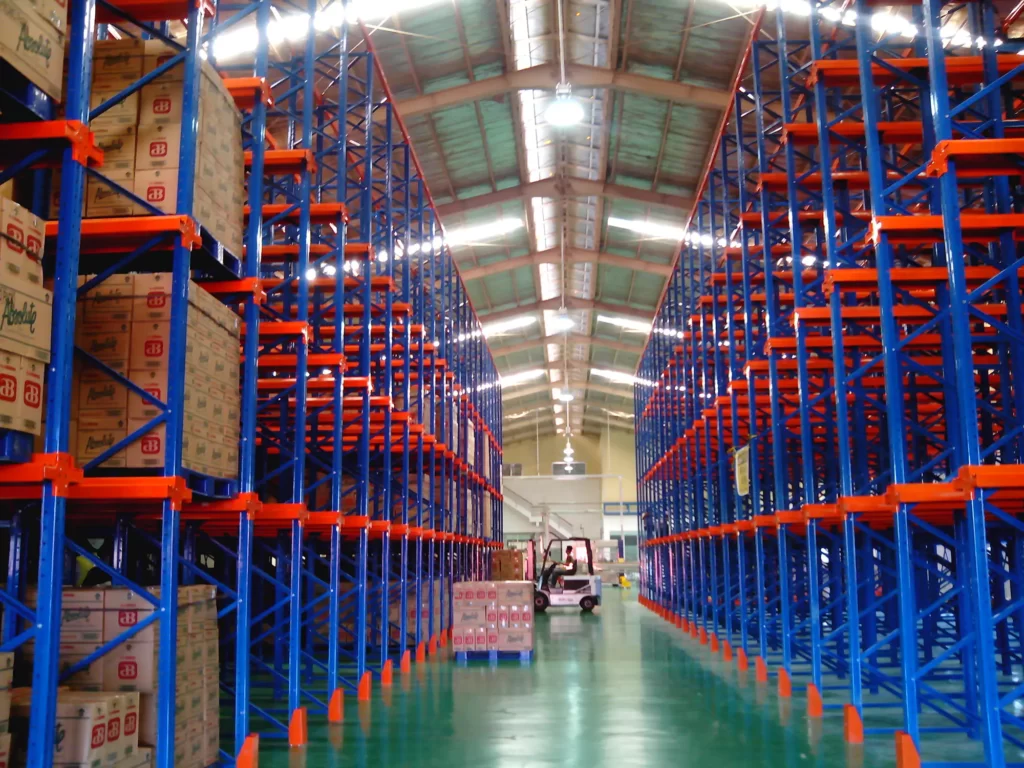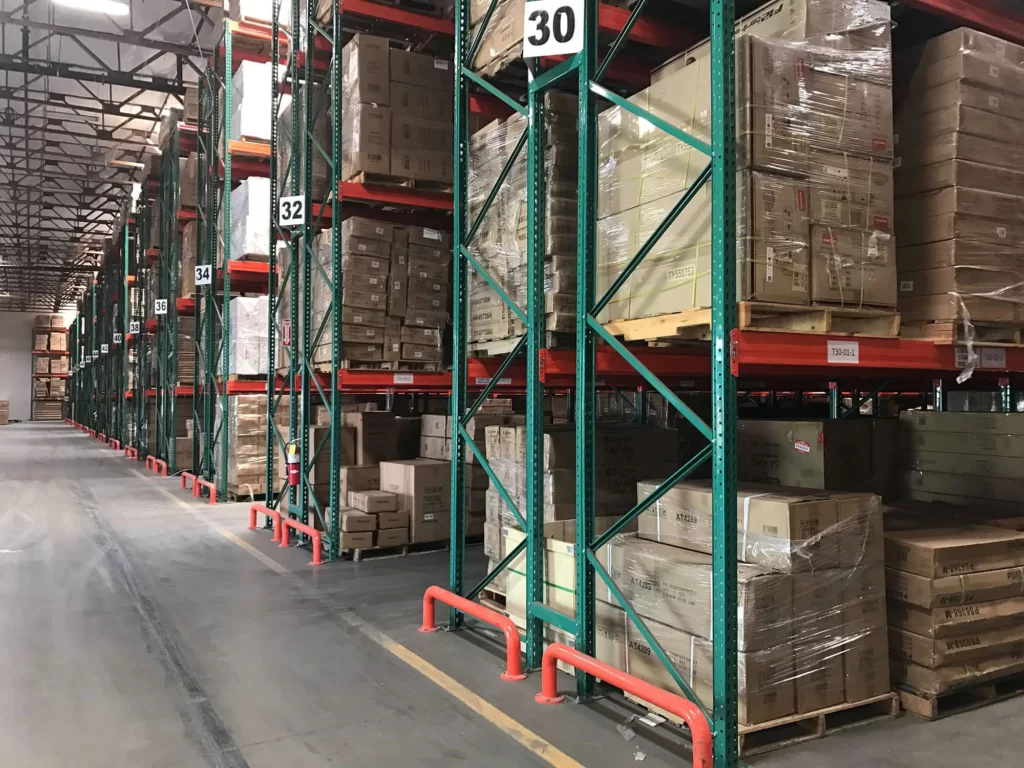In the world of chemical storage, there is no room for errors. One simple mistake can lead to a massive explosion or fire disaster. Every year, multiple hazardous chemical storage accidents occur, claiming scores of lives with millions of economic damages.
Given that improper storage of chemicals can have serious repercussions, maximum safety must be ensured as an essential element of operations.
To minimize the associated risks and create a secure working environment, businesses often resort to specialized storage solutions like chemical storage racks.
These racks are specifically designed to meet the special requirements associated with storing hazardous materials safely. These racks offer a systematic and organized way of storing various types of chemicals, decreasing accidents, spills, cross-contamination risk, and inventory management headaches while improving accessibility and meeting regulatory standards.
This article explores the critical importance of chemical storage racks and their importance in improving safety and efficiency when handling hazardous materials. We will address potential risks associated with chemical storage as well as ways to mitigate them effectively through proper storage practices. Furthermore, we will look at various types of racks available and their features, along with factors to consider when selecting an ideal rack or shelving system to meet your specific chemical storage needs.
Understanding the significance of chemical storage, exploring available options, and selecting effective storage solutions are crucial steps toward protecting your workforce, protecting the environment, and optimizing operational efficiency.
Join us as we navigate our way through the realm of chemical storage racks revealing valuable insights and practical guidance that will assist your organization’s chemical storage practices.
Risks Associated with Chemical Storage
Chemical storage poses numerous inherent risks that must be carefully managed to ensure the well-being of personnel, the environment, and surrounding communities. Awareness of these dangers is paramount to developing appropriate storage practices and preventive measures.
Potential Hazards
A proper understanding of the risks associated with chemical storage is crucial to developing effective safety measures and mitigating risks. Here are some primary hazards you should keep an eye on:
Chemical Reactions and Incompatibility
Chemicals stored or mixed improperly can undergo hazardous reactions that can be dangerous for both workers and the environment. Unsuitable combinations can produce volatile reactions between incompatible substances that lead to fires, explosions, or the release of toxic gases. Therefore, incompatible chemicals must be identified and stored separately to avoid the risk of accidental mixing.
Fire and Explosion Hazards
Chemicals such as flammable and combustible substances pose fire and explosion risks when stored improperly, including sparks from ignition sources such as spark plugs or open flames or electrical equipment. Proper storage includes ventilation to avoid potential ignition sources that could spark fire and explosion incidents.
Exposure to Extreme Temperatures
Chemicals exposed to extreme temperatures can wreak havoc on their stability and integrity, potentially leading to pressure build-up, volatilization, or decomposition of certain substances. On the other hand, low temperatures can result in freezing, solidification, or reduced efficacy of chemicals.
So, to avoid the risk of unfortunate accidents and ensure the integrity of chemicals, they must be stored in recommended temperature ranges.
Spills and Leaks
Improper handling, damaged containers, or inadequate containment measures often result in chemical spills and leaks. Leakage of hazardous chemicals can pose health risks to the workforce, the surrounding community, the environment, and the integrity of the chemicals. Therefore, it is critical that chemical substances are stored properly in their specialized storage racks and that an emergency system is in place to deal with unfortunate accidents.
Health and Safety Risks
Chemicals present serious health risks to anyone exposed to them. Exposure through inhalation, ingestion, or skin contact to toxic or hazardous substances may cause acute or chronic health issues for humans exposed. Adherence to proper storage and handling procedures, as well as wearing personal protective equipment, is crucial to minimize health risks.
Hefty Fines
Failure to comply with safety regulations for chemical storage can result in hefty fines imposed by regulatory authorities. These fines can vary depending on the severity of the violation and the potential risks posed by improper storage practices. Businesses that neglect proper chemical storage procedures not only jeopardize the safety of their workforce and the environment but also face significant financial penalties that can have a detrimental impact on their business.
In 2015, Mann Chemical company was fined $200,000 and placed on probation for three years for non-adherence to the Environmental Protection Agency (EPA) regulations. There are many other similar incidents. So, if you do not want to serve probation or pay a hefty fine, you must adhere to the regulations on chemical storage.
By recognizing and mitigating these risks, organizations can establish secure storage environments, reduce accidents and ensure everyone’s well-being in their storage facilities and their surrounding community.
Importance of Proper Storage of Chemicals
Proper storage practices play an integral part in safeguarding employee well-being, protecting the environment, and complying with regulatory compliance standards.
Start by protecting employees and the community against chemical-related accidents and hazards by segregating incompatible substances, installing adequate ventilation systems, and taking suitable containment measures. By decreasing risks such as chemical reactions, fires, spills, or leaks caused by improper storage practices, proper storage practices provide safeguards that keep workers, visitors, and the surrounding community safe.
Proper storage practices help safeguard both personnel and public health by minimizing exposure to hazardous substances. Storing chemicals in designated areas, following handling procedures, and providing personal protective equipment all help create an atmosphere conducive to safe working practices that minimize health concerns. In addition, adhering to good storage practices guarantees compliance with regulations while upholding chemical integrity while simultaneously showing commitment towards safe handling practices and responsible caretaking.
Types of Chemical Storage Racks
When it comes to chemical storage, choosing the right rack is crucial for safety, organization, and efficiency. There are several types of chemical storage racks available, each designed to meet specific storage requirements.
Let us take a closer look at each type of chemical rack to help you choose the right chemical storage racks for your purposes.
Selective Pallet Racks
Selective pallet racks are popular choices for chemical storage due to their easy access and efficient organization. Direct access to individual chemical containers prevents cross-contamination and makes retrieval simple. Their adaptable nature also enables systematic organization that aids inventory management as well as compliance with safety regulations – thus creating a safer work environment and streamlining operations while optimizing chemical storage practices.
Drive-In Racks
Drive-in racks are especially suited to warehouses with dense storage needs, maximizing space by enabling forklifts or automated systems to drive directly into their structure. Drive-in racks can maximize storage by maximizing accessibility. Therefore, they’re an ideal way of storing large quantities of chemicals that don’t require immediate accessibility and retrieval order. However, it must still be securely packed to not pose risks should any slip off.
Gravity Flow Racks
Gravity flow racks use inclined roller tracks or conveyor systems to facilitate the movement of chemicals through their rack. This design facilitates automatic stock rotation based on the first-in, first-out (FIFO) principle. Gravity flow racks are ideal for storing chemicals with expiration dates or where inventory turnover is critical. Their efficient stock management promotes product quality and safety for sustained customer service.
Featuring inclined roller tracks or wheels to allow pallets to flow seamlessly from the loading side to the unloading side. Pallet flow racks can help maximize high-density storage, stock rotation efficiency, and warehouse space utilization, making them an effective storage option.
Drum Storage Racks
Drum storage racks are specifically designed to safely store chemical drums. These racks typically incorporate special cradles or containment systems that safely organize drums for storage. These racks ensure proper alignment, no movement between drums, and safe handling and retrieval of chemicals from stored drums. These racks also work great for oil drum storage.
Containment shelving
Containment shelving is a specialized storage solution designed to safely store hazardous substances while avoiding accidental spills or leaks. Equipped with built-in containment features like leak-proof trays or pans that capture any potentially hazardous substances that escape, containment shelving is an invaluable asset in industries where chemicals, liquids, or flammable materials need to be stored safely. Containment shelving help ensure environmental protection, compliance with safety regulations, reduced accidents or contamination risk, and better workplace safety overall.
IBC (Intermediate Bulk Container) Racks
IBC racks are specifically designed to store intermediate bulk containers (IBCs), which are commonly used to store liquid or granular chemicals. IBC racks provide a secure and organized way of storing IBCs while preventing leakage or spills, often including spill containment features as well as being capable of accommodating multiple IBCs for maximum storage efficiency.
Hazmat Cabinets
Hazmat cabinets are specially-built storage cabinets designed to safely house hazardous materials. Constructed from fire-resistant materials and featuring secure locking mechanisms to restrict unauthorized access, these cabinets create a controlled environment for storing chemicals while offering protection from fire, spills, and improper handling. Hazmat cabinets are essential when it comes to keeping small containers, samples, or highly reactive chemicals secure and out of harm’s way.
Ventilated Cabinets
Ventilated cabinets are specially-crafted storage solutions for chemicals that produce fumes or require proper ventilation. They feature exhaust fans or vents to provide air circulation and eliminate potentially dangerous vapors. Ventilated cabinets play an integral part in safeguarding against inhalation risks or maintaining controlled air quality for chemicals stored within these cabinets.
Understanding the different types of chemical storage racks available allows businesses to select an ideal rack based on their storage requirements, types of chemicals being stored, accessibility needs, and safety considerations. Each rack provides distinctive benefits and features to promote proper warehouse organization, efficient storage operations, and increased safety measures during chemical storage operations.
Things to Consider Before Picking a Rack or Shelving System
1. Chemical Compatibility
Chemical compatibility should always be the top consideration when choosing a rack or shelving system for chemical storage since different substances have their own specific requirements in terms of compatibility. Care should be taken when assessing each chemical’s reactivity, flammability, toxicity, or any other characteristic to select an adequate system without the risk of cross-contamination or interaction between substances stored.
2. Storage Capacity and Space Utilization
Evaluate your chemical inventory storage needs as well as available space within your facility, taking into account quantities and volumes stored, to select an ideal rack or shelving system to house them all. Furthermore, take note of its layout and dimensions to optimize space usage while facilitating efficient access and retrieval.
3. Load Capacity and Structural Integrity
Chemicals can be heavy, necessitating strong shelving or rack systems capable of supporting their weight. Assess the load capacity of any chosen rack or shelving system to make sure they can safely store your chemicals without tipping over. Inspect its structural integrity to make sure it can withstand conditions in your storage environment.
4. Accessibility and Retrieval
When considering the access and retrieval frequency of chemicals, take into account their frequency. For fast and frequent access needs, select rack or shelving systems that offer easy reach-in access for individual containers, and for less-frequent retrievals, drive-in racks may provide better storage solutions.
5. Safety Measures
Put safety features first when purchasing rack or shelving systems. Look for options that provide proper containment, spill prevention mechanisms, and features like safety barriers or guards. Also, take into consideration fire protection, chemical leak detection systems, or compliance with specific industry or regulatory safety protocols as additional safety features.
6. Environmental Considerations
Assess the environmental conditions in your storage area, such as temperature, humidity, and sunlight exposure. Certain chemicals require controlled environments to remain stable and intact. Therefore, you must choose a chemical storage rack that provides adequate environmental controls or protection to avoid degradation or hazardous reactions.
7. Compliance With Regulations
Confirm that your chemical storage rack system meets applicable safety regulations, codes, and standards for chemical storage. Adherence to regulatory requirements can help avoid accidents while creating a safe working environment and potentially incurring penalties or legal ramifications.
8. Future Expansion and Flexibility
When planning for future storage needs and potential growth, select a rack or shelving system with flexible scalability to accommodate potential expansion or changes to your chemical inventory. This will reduce future storage investments.
By carefully considering these factors, businesses can make informed decisions when selecting a rack or shelving system for chemical storage. Safety, compliance, and the particular requirements of the chemical being stored must all come first if you want a secure, organized, and efficient storage environment.
Conclusion
Chemical storage racks are essential in maintaining safety, efficiency, and regulatory compliance when handling hazardous chemicals. Their purpose-built design provides organized storage to reduce accidents, spills, and cross-contamination risks. By choosing suitable chemical storage racks and employing proper storage practices, businesses can protect both employees as well as the environment while optimizing operations.








